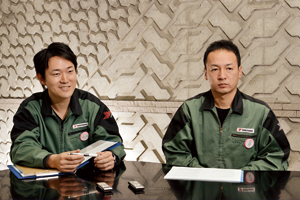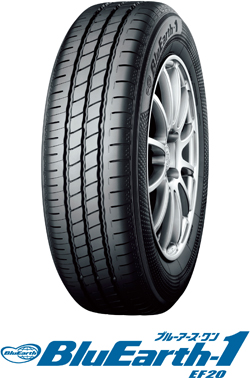Masaki Sato (left)
Amino Research Lab
Tire Technology Development Division
Masaya Mita (right)
Tire Designing Department No. 1
In 1996 Yokohama Rubber was among the first in the industry to focus on the fuel economy of tires with the belief that tires represent a game changer. In 1998 it launched the Eco Tire DNA series, and since then Yokohama Rubber has consistently been at the forefront of the eco-friendly tire market in Japan. The BluEarth series that aims to protect the environment and people around the world represents a culmination of these efforts.
In 2013, the new BluEarth-1 EF20 was launched. This tire maintains the same fuel economy performance as conventional BluEarth tires, but with improved safety features. This tire, which stands as the pinnacle of fuel efficient tires, captured the highest grade possible in terms of both safety and environmental performance. How did Yokohama do it? Below two employees involved in the development process take a look back on their experiences.
Received the Highest Grade Possible for both Environmental Performance and Safety
The development project that would give rise to the BluEarth-1 EF20 was launched in 2011 with the mission to develop a tire that could obtain the highest grade in terms of environmental performance and safety from the fuel economy tire grading system.
The Japan Automobile Tyre Manufacturers Association (JATMA)’s labeling system that was started in 2010 shows the grade of a tire’s rolling resistance performance and wet grip performance on a five-level scale and four-level scale, respectively. The grade for rolling resistance considers how well the tire is able to improve the vehicle’s fuel economy by reducing energy loss from the rotation of tires, while the grade for wet grip examines how firmly a tire grips wet road surfaces and the degree to which it can bring the vehicle to a stop. Any tire that receives a grade of at least “A” for rolling resistance performance and between a grade of “a” and “d” for wet grip performance is defined as a fuel efficient tire. The BluEarth-1 EF10 received the highest grade for rolling resistance, or “AAA,” while it also received the highest grade for wet grip performance, or “a.” This marked the first time ever a tire received the highest score for both.
“Being the first to receive the highest grade under this labeling system was a major goal of all the technology divisions involved. While having the chance to work on this project was a major motivation, honestly I had a lot of unease about whether it was actually possible to accomplish this goal,” says Masaya Mita, who is in charge of structural design with the Tire Designing Department No. 1. Masaki Sato, who was in charge of the tire’s tread rubber development with the Tire Technology and Development Division looks back and notes, “A grade is assigned for the overall tire, but the role of the tread rubber is especially important, so I felt a strong sense of responsibility.” Enthusiasm, unease and responsibility. With these mixed emotions in tow the project was launched with a firm focus on its mission.
Yokohama Rubber’s Amassed Technologies made Development Possible

Just as Sato says, “At the start of the project I knew we wouldn’t succeed without the help of various people,” development got started with collaboration between various departments within the company. “The cooperation of our plants was essential, since we examined the conceptual image of the tire on countless occasions with planning departments and checked with production departments to see if the manufacturing process was reasonable. This is because no matter how good a tire might be, it’s pointless if we can’t mass produce it,” says Mita about his own experience working at a plant for this project.
A turning point for the project was the development of new ingredients. As for the compounding design for tread rubber, adding silica, which is used as a type of reinforcement filler, will markedly improve wet grip performance, but silica tends to lump up in rubber, which greatly increases rolling resistance.“The development of ingredients that increased the use of silica but made it harder for it to lump up and achieved even consistency within the rubber turned out to be one of the missing pieces of the puzzle,” says Sato.
Yet, there was still something needed to help everything come together. The two of them mentioned this was the presence of initial technology research carried on from before the project was started that had undergone a number of daily trials and tribulations. Development turned out to be a success not because of single breakthrough, but rather a culmination of the technologies that Yokohama Rubber had built up to date.
Continually Evolving with New Ideas
The BluEarth-1 EF20 was released in the summer of 2013 just one year from the start of the project. However, for Mita, Sato and other members of the development team, this wasn’t the end goal of the project. “We feel the need to further improve the technological level of both safety and environmental performance. For example, if we can create a rubber that causes less friction, we can extend the life of the tire and reduce the number of replacements, which will help conserve resources. I’d like to focus more energy on these aspects,” says Sato.
There is also the possibility that performance requirements for tires will change due to the spread of the electric vehicle. Today, Yokohama Rubber is in talks with Kumho Tire, a major South Korean tire manufacturer about a possible technical tie-up, and both Sato and Mita believe these talks have provided positive stimuli and motivated them to work on the development of more new ideas.
Work has already begun on rolling out the BluEarth-1 EF20 tire in overseas markets, which involves market research and preparation for certifications. BluEarth tires, which protect the earth and people around the world, are set to continually evolve thanks to the commitment of Yokohama Rubber’s many future-looking employees.

- Balancing rolling resistance and wet grip performance with increased amounts of silica and an evolved compounding technology
- Silica is needed to achieve a high degree of balance between fuel efficiency and grip performance. The BluEarth-1 EF20 successfully developed a technology to increase the amount of silica used while minutely and evenly distributing it. This enabled the tire to receive the highest grade for wet grip performance, or “a,” and the highest grade for roll resistance performance, or “AAA,” under JATMA’s labeling system for fuel efficient tires. This tire balances safety and fuel economy at the highest possible level.
- Aerodynamic dimpled design
- Air resistance, or drag, works against a vehicle’s fuel economy, with resistance becoming particularly large at higher speeds. Yokohama Rubber developed an aerodynamic simulation for use in the tire design process based on the idea of creating a tire with reduced air resistance. This lead to a dimpled design optimized for effectively reducing air resistance by changing the flow of air on the surface of the rotating tire.
- Preventing air leaks using a proprietary new technology
- Tires naturally lose air as time passes and lower air pressure causes an increase in rolling resistance. The AIRTEX Advanced Liner, made from a specially developed combination of rubber and plastic, is used as the inner liner inside the tire. This design helps reduce the loss of air and also reduces the weight of the tire, which maintains good fuel economy and reduces the burden of maintenance.
